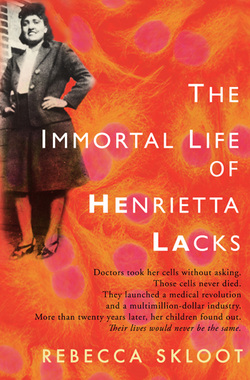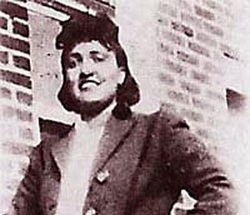The Immortal Life of Henrietta Lacks Book Review: The Face Behind HeLa

She is the reason that so many individuals have survived. She lives all over the world, yet her body rests in an unmarked grave. She is a mother of five. She is an ongoing ethical and moral controversy. This woman is Henrietta Lacks. As we read Rebecca Skloot’s The Immortal Life of Henrietta Lacks, we journey into the life and the legacy behind the immortal cells.
Skloot has published various essays and scientific journal entries, but this is her first book. She is an accomplished journalist who decided to uncover and explore the life behind the HeLa cells. She journeyed all over the United States searching for answers regarding the woman from whom the cells were extracted. Little did she know that the Lacks family had the same probing questions she did. This family had been kept in the dark for a number of years about the truth behind the HeLa cells and how scientists worldwide had acquired them. As science progressed with these immortal cells, researchers and doctors began to wonder about the origin of them. Together, three stories - Skloot’s, the Lacks’, and the scientists’- comprise the narrative in this controversial, engaging, and fascinating book.
Henrietta Lacks resided in Clover, Virginia, which was also known as Lacks Town. The doctors at John’s Hopkins Hospital in Baltimore diagnosed her with cervical cancer. Skloot makes a point in dividing the book into three sections- Life, Death, and Immortality. She focuses on Henrietta's background before examining the story of her cells. We are informed of her slave ancestry and the colorful social life that she led. She was referred to as the "sweetest girl you ever wanna meet." (90) She often complained about a “knot on my womb”. (21) It was later diagnosed as cervical cancer. Once her strenuous treatment began, Dr. George Gey obtained cancer cells from her cervix in order to run tests on them and make attempts at finding an immortal cell line. These cell samples were labeled “HeLa.”. The non-consensual removal of a patient’s cells was commonplace during this time period. Skloot makes sure to remind the reader of this throughout the book. “Like most patients in the 1950’s, she deferred to anything her doctors said. This was a time when “benevolent deception was common practice-” For the first time, Gey succeeded in finding and culturing these immortal cells. His excitement led him to distribute these cells to fellow scientists for them to run tests and conduct cancer research. These cells spread and became one of the most popular resources. Meanwhile, while the world was profiting off of her cells, the Lacks family had no idea what was going on. They were oblivious to the fact that doctors worldwide were becoming rich and famous because of their mother’s cells. All they knew was that their mother was gone and they couldn’t fully grasp and understand why. "Nobody round here never understood how she dead…” They believed that the doctors had taken her life or just left her there to suffer and die. Skloot places the reader in the mind of each person she writes about. We understand the mentality of the doctors as they removed Henrietta’s precious cells. The reader can begin to comprehend the distraught pain that the family felt when they lost such an amazing and heartfelt woman. We fall deeper and deeper into the story behind the HeLa cells and the heroine to whom they belonged.
Skloot then carries us into life after the death of Henrietta. Her cells led a life of their own. The scientists at this time were discovering multiple medical breakthroughs using HeLa. The medical journals were always filled with new stories on how doctors and researchers were producing new drugs and finding cures for various diseases. While everyone was engulfed in the glory and greatness of the HeLa cells, nobody had considered that these cells may, contrary to belief, have been misleading research. One man proposed that her cells were contaminating normal cells and therefore producing invalid results. This theory caused the medical community to panic and for the rest of the world to go into uproar. Later on, when Skloot interviewed some of the family members, they believed that Henrietta was causing these misfortunes. They claimed she was watching over her cells and when something happened that she didn’t like, she manipulated the cells so they would have a negative effect on those who were using them. It is extremely ironic that the family of this woman, who contributed so much to the medical society, does not have health care. Deborah, Lack’s youngest daughter, states: "If our mother cells done so much for medicine, how come her family can't afford to see no doctors?" They had not, until around the time Skloot began working with them, received any help or recognition from those in the medical community.
The Lackses learned about HeLa in the 1970s and began a strenuous journey in search of comprehension and reconciliation. Skloot’s journey, as that of the Lacks’, began with little and vague information on Henrietta. She tells us in the primary chapters of the book that she had briefly heard of Lacks in her science class and was determined to learn more about this mystery woman. Skloot shaped an interesting and engaging read suitable for all. It contains the facts of a non- fiction book but reads as though it were a novel. In engulfing oneself in The Immortal Life of Henrietta Lacks, the reader is able to accompany Skloot as she unveils the truth behind HeLa and gives to Lacks “the fame she so richly deserves.”
Phobia and Ignorance
Throughout The Immortal Life of Henrietta Lacks we are able to follow the stories of scientists who dealt with the HeLa cells. The dilemmas that arise in each of the stories are all very similar. They raise multiple ethical questions and we are able to engage in the explicit argument that Skloot poses. Is consent a necessity to proceed with testing on patients who are unaware of the procedures being done on them? Does a person’s biological material belong to that person once it is detached from their body? These make up a minute percentile of the questions asked throughout society regarding patient rights and consent. While discovering the scientists’ and researchers’ stories, we find that their attitudes are all fairly similar, apart from the few who were morally and ethically aware of what they were doing. Skloot reveals the blunt truth of what took place behind hospital, clinic, and testing facility doors. Though she remains impartial, the tone she uses expresses her disapproval of the doctors’ and researchers’ actions, a distaste the reader might well share. The various chapters dealing with the scientific approach to the HeLa cells present multiple injustices and few instances of attempts by doctors to do what is ethically correct.
Dr. Chester Southam was a credible researcher who was, at this point and time, researching cancer and cancer cells. He developed a theory about whether or not the bodies of patients’ who had suffered with cancer in the past would reject the HeLa cells. As he tested the patients “he said nothing about injecting them with someone else’s malignant cells” (127) and continued with his experiments. He later moved on to testing prison inmates, who were fully aware of what was going on. They were considered “the first healthy human beings ever to agree to such rigorous cancer experiments-” (129). The public soon caught wind of what Southam - and many other doctors at the time - were doing. The doctors believed that revealing details to patients would create a “phobia and ignorance” (129) in the mind of the subjects. The consciences of three young Jewish doctors compelled them to bring these issues of lack of consent and patient awareness to court. They used “a ten point code of ethics now known as the Nuremberg Code” (130) as their pillar. Although still during that time there was no legal obligation for doctors and researchers to inform their patients of the procedures taking place, there were codes of ethics, often viewed merely as suggestions. The result of the young Jewish doctors winning the case reciprocated many reproductions on Southam and various other doctors withholding information from patients. Those “illegal, immoral, and deplorable” (133) actions became “the hottest public debate on medical ethics since Nuremberg trials.”(133)
While we have such a strong code of ethics today, we are still unable to fully understand the mindset and logic of the doctors and researchers in the 1960’s. Skloot presents these issues of injustice and unethical behavior in a way that’s asks us to place ourselves in that time period and envision truly how detrimental a lack of personal morals and code of ethics in the medical field can really be.
Dr. Chester Southam was a credible researcher who was, at this point and time, researching cancer and cancer cells. He developed a theory about whether or not the bodies of patients’ who had suffered with cancer in the past would reject the HeLa cells. As he tested the patients “he said nothing about injecting them with someone else’s malignant cells” (127) and continued with his experiments. He later moved on to testing prison inmates, who were fully aware of what was going on. They were considered “the first healthy human beings ever to agree to such rigorous cancer experiments-” (129). The public soon caught wind of what Southam - and many other doctors at the time - were doing. The doctors believed that revealing details to patients would create a “phobia and ignorance” (129) in the mind of the subjects. The consciences of three young Jewish doctors compelled them to bring these issues of lack of consent and patient awareness to court. They used “a ten point code of ethics now known as the Nuremberg Code” (130) as their pillar. Although still during that time there was no legal obligation for doctors and researchers to inform their patients of the procedures taking place, there were codes of ethics, often viewed merely as suggestions. The result of the young Jewish doctors winning the case reciprocated many reproductions on Southam and various other doctors withholding information from patients. Those “illegal, immoral, and deplorable” (133) actions became “the hottest public debate on medical ethics since Nuremberg trials.”(133)
While we have such a strong code of ethics today, we are still unable to fully understand the mindset and logic of the doctors and researchers in the 1960’s. Skloot presents these issues of injustice and unethical behavior in a way that’s asks us to place ourselves in that time period and envision truly how detrimental a lack of personal morals and code of ethics in the medical field can really be.

